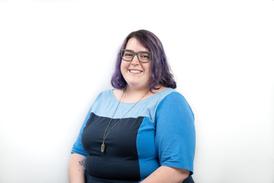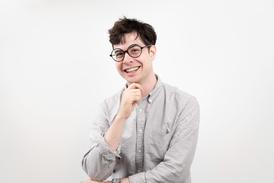Whitney Leopard is the Senior Editor at RH Graphic and before that she worked at BOOM! Studios on the kid's imprint, KaBOOM!. You can find her online @WhitLeopard.
Patrick Crotty is the Designer at RH Graphic. He also co-founded and runs the small Stockholm-based independent comic publisher PEOW. You can find him online @ppcrotty.

|
|
| Whitney Leopard | |
Would you please tell us a little bit about your positions at RH Graphic and what your jobs entail?
Whitney: I work with the creators on their stories as the editor. There's a lot of collaboration, talking through ideas, reading and schedule managing. And, just about every day, someone emails me amazing art in progress, which makes this the best-ever job!
Patrick: I'm the Designer here, working with designing the books from cover to cover and everything on the pages in between. I also do lettering and interior design and work on pretty much anything visual.
Have you always been interested in graphic novels? What brought you to this imprint?
WL: I grew up with comics. I love graphic novels, particularly graphic novels for kids. When I heard Gina was building something in NYC, and that Random House Children's Books was behind it, I knew I wanted to be part of it!
PC: I became interested in graphic novels quite late in my twenties. I started publishing comics about six years ago and have only grown more passionate about them. When approached to join the RHG team, I knew this would be a great new adventure!
What are you looking for in a manuscript?
WL: There's always an X factor. It's important for kid's graphic novels to have strong characters and strong art. But, beyond that, there's definitely a level of "you know it when you see it." And that's true whether it's the expressions on a squirrel, amazing pencil line-art or some devastatingly-written heartbreak (all of which are things I enjoy).
How do manuscripts come to you?
WL: Each pitch is different, but we all talk about potential projects together as a team; everyone at Random House Graphic is part of our acquisition process. We work with both creators who are author/artists and collaborative teams; we even match authors with artists on the right projects. When we all fall in love with something, that's when we know it's right for the imprint!
 |
|
| Patrick Crotty | |
Whitney, how do you edit an illustrated work?
WL: Graphic novels are complicated: between the text and the art, they involve a number of rounds of editorial input and feedback to make sure the author's vision is coming through in the best possible way in every aspect of the story. It's important to make sure a scene is flowing smoothly, that a character's emotions are clear and that the story works from one panel to the next, in every panel throughout the book.
Patrick, what is the process like for each title?
PC: By the time the book reaches me, most of the interior artwork is done--I work more directly on covers and design. There is a lot of back and forth between me and the creators so we can make something we're all excited about and that will work in the market. The cover is the scariest and most exciting because so much weight is put on that single drawing: it has to be the BEST drawing in the book. It feels great to be there to listen and talk to the artists about that page, lift up their good ideas, keep them motivated and see them feel excited about the cover, even if the final results are completely different from the initial vision.
Are there any specific titles that you found particularly fun or interesting to work on?
WL: I love all our creators and their stories. But, if I have to call out one book for 2020, it would be Séance Tea Party by Reimena Yee. You are not ready for how special it is.
PC: It's a tough question to ask us what we're most fond of! I think we love all our books equally. From our first season, I'm very excited to see Bug Boys in print: the artwork and story are fantastic. And I got the chance to work with the amazing colorist Lyle Lynde!

